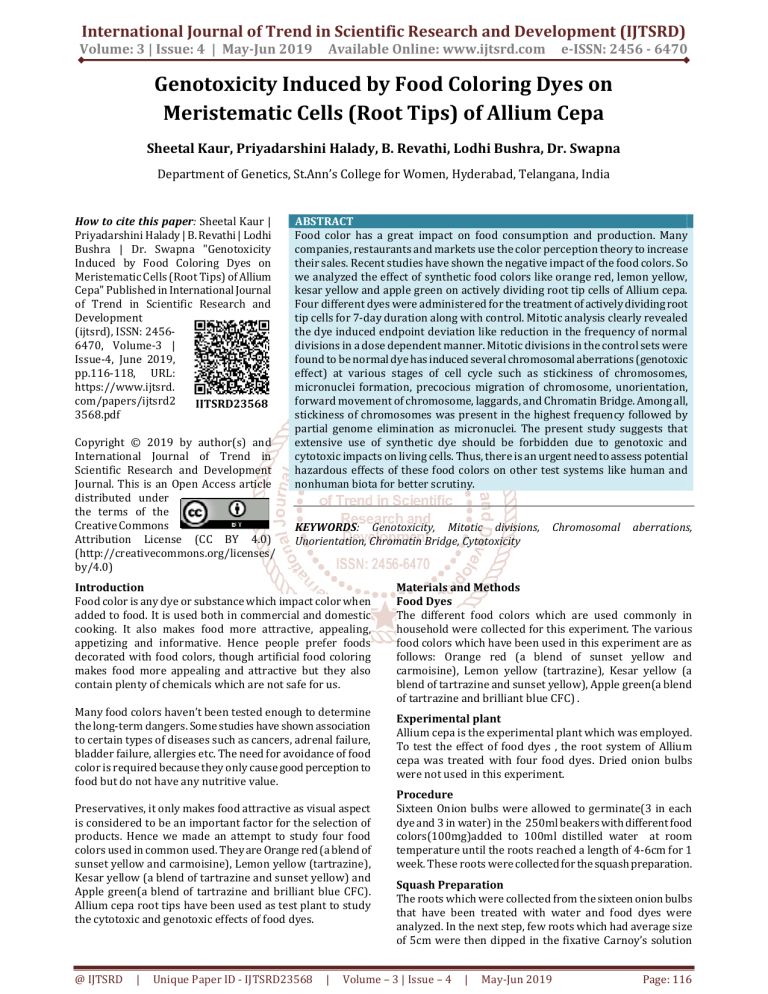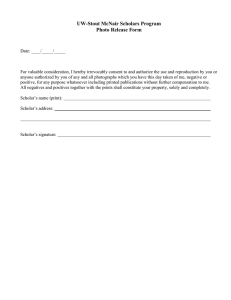
International Journal of Trend in Scientific Research and Development (IJTSRD)
Volume: 3 | Issue: 4 | May-Jun 2019
Available Online: www.ijtsrd.com
e-ISSN: 2456 - 6470
Genotoxicity Induced by Food Coloring Dyes on
Meristematic Cells (Root Tips) of Allium Cepa
Sheetal Kaur, Priyadarshini Halady, B. Revathi, Lodhi Bushra, Dr. Swapna
Department of Genetics, St.Ann’s College for Women, Hyderabad, Telangana, India
How to cite this paper: Sheetal Kaur |
Priyadarshini Halady | B. Revathi | Lodhi
Bushra | Dr. Swapna "Genotoxicity
Induced by Food Coloring Dyes on
Meristematic Cells (Root Tips) of Allium
Cepa" Published in International Journal
of Trend in Scientific Research and
Development
(ijtsrd), ISSN: 24566470, Volume-3 |
Issue-4, June 2019,
pp.116-118, URL:
https://www.ijtsrd.
com/papers/ijtsrd2
IJTSRD23568
3568.pdf
Copyright © 2019 by author(s) and
International Journal of Trend in
Scientific Research and Development
Journal. This is an Open Access article
distributed under
the terms of the
Creative Commons
Attribution License (CC BY 4.0)
(http://creativecommons.org/licenses/
by/4.0)
ABSTRACT
Food color has a great impact on food consumption and production. Many
companies, restaurants and markets use the color perception theory to increase
their sales. Recent studies have shown the negative impact of the food colors. So
we analyzed the effect of synthetic food colors like orange red, lemon yellow,
kesar yellow and apple green on actively dividing root tip cells of Allium cepa.
Four different dyes were administered for the treatment of actively dividing root
tip cells for 7-day duration along with control. Mitotic analysis clearly revealed
the dye induced endpoint deviation like reduction in the frequency of normal
divisions in a dose dependent manner. Mitotic divisions in the control sets were
found to be normal dye has induced several chromosomal aberrations (genotoxic
effect) at various stages of cell cycle such as stickiness of chromosomes,
micronuclei formation, precocious migration of chromosome, unorientation,
forward movement of chromosome, laggards, and Chromatin Bridge. Among all,
stickiness of chromosomes was present in the highest frequency followed by
partial genome elimination as micronuclei. The present study suggests that
extensive use of synthetic dye should be forbidden due to genotoxic and
cytotoxic impacts on living cells. Thus, there is an urgent need to assess potential
hazardous effects of these food colors on other test systems like human and
nonhuman biota for better scrutiny.
KEYWORDS: Genotoxicity, Mitotic divisions,
Unorientation, Chromatin Bridge, Cytotoxicity
Introduction
Food color is any dye or substance which impact color when
added to food. It is used both in commercial and domestic
cooking. It also makes food more attractive, appealing,
appetizing and informative. Hence people prefer foods
decorated with food colors, though artificial food coloring
makes food more appealing and attractive but they also
contain plenty of chemicals which are not safe for us.
Many food colors haven’t been tested enough to determine
the long-term dangers. Some studies have shown association
to certain types of diseases such as cancers, adrenal failure,
bladder failure, allergies etc. The need for avoidance of food
color is required because they only cause good perception to
food but do not have any nutritive value.
Preservatives, it only makes food attractive as visual aspect
is considered to be an important factor for the selection of
products. Hence we made an attempt to study four food
colors used in common used. They are Orange red (a blend of
sunset yellow and carmoisine), Lemon yellow (tartrazine),
Kesar yellow (a blend of tartrazine and sunset yellow) and
Apple green(a blend of tartrazine and brilliant blue CFC).
Allium cepa root tips have been used as test plant to study
the cytotoxic and genotoxic effects of food dyes.
@ IJTSRD
|
Unique Paper ID - IJTSRD23568
|
Chromosomal
aberrations,
Materials and Methods
Food Dyes
The different food colors which are used commonly in
household were collected for this experiment. The various
food colors which have been used in this experiment are as
follows: Orange red (a blend of sunset yellow and
carmoisine), Lemon yellow (tartrazine), Kesar yellow (a
blend of tartrazine and sunset yellow), Apple green(a blend
of tartrazine and brilliant blue CFC) .
Experimental plant
Allium cepa is the experimental plant which was employed.
To test the effect of food dyes , the root system of Allium
cepa was treated with four food dyes. Dried onion bulbs
were not used in this experiment.
Procedure
Sixteen Onion bulbs were allowed to germinate(3 in each
dye and 3 in water) in the 250ml beakers with different food
colors(100mg)added to 100ml distilled water at room
temperature until the roots reached a length of 4-6cm for 1
week. These roots were collected for the squash preparation.
Squash Preparation
The roots which were collected from the sixteen onion bulbs
that have been treated with water and food dyes were
analyzed. In the next step, few roots which had average size
of 5cm were then dipped in the fixative Carnoy’s solution
Volume – 3 | Issue – 4
|
May-Jun 2019
Page: 116
International Journal of Trend in Scientific Research and Development (IJTSRD) @ www.ijtsrd.com eISSN: 2456-6470
3:1(ethanol: acetic acid) for some time to allow the fixation
of the cells. After cell fixation, the roots were hydrolyzed in
HCl-Ethanol(1:1) solution in order to break the cell wall.
Then the root tip was cut with the blade and squashed by
tapping with the spatula. The roots were further stained by
treating of the onion root tips with 2% acetocaramine. The
root tip was placed on glass slide and a drop of
acetocaramine stain is added again once the squashing is
done. The slide is then covered with a cover slip .Excess of
stain was removed by the use of blotting paper and the slide
was exposed to flame for a while until it was warm. After the
squash preparation, these cells were then observed under
the compound microscope and for better magnification; oil
immersion was applied to the slide. The different stages of
mitotic division were then examined under the compound
microscope.
Results and Discussions
Allium cepa exhibits species level genomic constitution.
Present assessment showed the normal course of mitotic
division in the control set, that is, alignment of 16
chromosomes at metaphase and segregation of
chromosomes into 16:16 at anaphase. In untreated
meristematic cells (root tips) was registered with no
chromosomal manifestations. On the other hand, treated sets
displayed the considerable range of irregularities during
mitosis that were found to be distributed in almost all
phases of division, that is, metaphase, anaphase, and
telophase.
As a consequence of irregular mitosis, several aberrations
were recorded, namely, precocious movement of
chromosome, unorientation, C-mitosis, forward movement
of chromosome, micronuclei formation at prophase and
telophase, chromatin bridge, and stickiness of chromosomes,
at metaphase and diagonal anaphase. Among all the
aberrations observed, stickiness was registered to be the
highest followed by micronuclei formation. Moreover some
other abnormalities have also been recorded such as
binucleate cell, unequal separation, and fragmentation.
In general, chromosomal aberrations are changes in
chromosome structure resulting from a break or exchange of
chromosomal material and most often are permanent in
nature. Further investigations showed the dominance of
micronuclei after stickiness. Occurrence of micronuclei as
aberration might be the results of acentric fragments or
lagging chromosomes that fail to incorporate into either of
the daughter nuclei during telophase of the mitotic cells.
Thus, the micronuclei formation at telophase is attributed to
genetic loss through genome elimination of chromosomes.
Such genome loss plays a significant role in the production of
aneuploids when occurring in germinal cells. Several
hypotheses have been suggested in an attempt to explain the
phenomenon, including inactivation of chromosomes by
nuclease, formation of multi polar spindles, asynchrony in
nucleoprotein synthesis, genome ratios, spatial separation of
genomes, and suppression of centromere function in the
eliminated chromosomes, asynchronous cell cycle phases,
and asynchronous mitotic and meiotic rhythms. However,
more precise explanation is still lacking.
Table 1 presents the occurrence characteristics of normal and disturbed phases of cell cycle during mitotic cell cycles
Treatment
with
water
red
yellow
orange
green
Sample
Prophase
Anaphase
sample 1
sample 2
sample 3
sample 1
sample 2
sample 3
sample 1
sample 2
sample 3
sample 1
sample 2
sample 3
sample 1
sample 2
sample 3
+
+
+
+
+
+
+
+
+
+
+
+
+
+
+
-
Table 1
Meta
phase
+
+
+
+
+
-
Telophase
+
+
+
+
-
Other observations
Cells were normal
Cells found had no nucleus, broken
DNA strands, distorted nucleus.
Cells found had been elongated, had
many nucleus,had blots on nucleus had
holes in cell.
Cells had holes in them, micronuclei
were found, DNA was found out side of
cells and inside cells.
Cells were shrunk, had blots all over,
cells had chromosomes in them
Cellwall had holes.
Conclusion
Our study has shown that Food colors show severe cytotoxicity in terms of cell death. So, our present finding
clearly depicts the genotoxic and cytotoxic impact of different food colors on actively dividing root tip cells of Allium cepa. This
investigation is also in agreement with several previous studies in the literature suggesting that there is an urgent need to
assess potential hazardous effects of these food colors on other test systems like human and nonhuman biota for better
scrutiny
@ IJTSRD
|
Unique Paper ID - IJTSRD23568
|
Volume – 3 | Issue – 4
|
May-Jun 2019
Page: 117
International Journal of Trend in Scientific Research and Development (IJTSRD) @ www.ijtsrd.com eISSN: 2456-6470
REFERENCE
[1] J. Feng, C. E. Cerniglia, and H. Chen, “Toxicological
significance of azo dye metabolism by human intestinal
microbiota,” Frontiers in Bioscience (Elite Edition), vol.
4, no. 2, pp. 568–586, 2012. View at Google Scholar •
View at Scopus
[2] J. M. Morrison, C. M. Wright, and G. H. John,
“Identification, Isolation and characterization of a
novel azoreductase from Clostridium perfringens,”
Anaerobe, vol. 18, no. 2, pp. 229–234, 2012. View at
Publisher • View at Google Scholar • View at Scopus
[3] Y. F. Sasaki, S. Kawaguchi, A. Kamaya et al., “The comet
assay with 8 mouse organs: Results with 39 currently
used food additives,” Mutation Research, vol. 519, no.
1-2, pp. 103–119, 2002. View at Publisher• View at
Google Scholar • View at Scopus
[4] S. Sharma, R. P. Goyal, G. Chakravarty, and A. Sharma,
“Toxicity of tomato red, a popular food dye blend on
male albino mice,” Experimental and Toxicologic
Pathology, vol. 60, no. 1, pp. 51–57, 2008. View at
Publisher • View at Google Scholar • View at Scopus
[5] H. B. Mansour, D. Barillier, D. Corroler, K. Ghedira, C.-G.
Leila, and R. Mosrati, “In vitro study of dna damage
induced by acid orange 52 and its biodegradation
derivatives,” Environmental Toxicology and Chemistry,
vol. 28, no. 3, pp. 489–495, 2009. View at Publisher •
View at Google Scholar • View at Scopus
[6] C. Shimada, K. Kano, Y. F. Sasaki, I. Sato, and S. Tsudua,
“Differential colon DNA damage induced by azo food
additives between rats and mice,” Journal of
Toxicological Sciences, vol. 35, no. 4, pp. 547–554,
2010.View at Publisher • View at Google Scholar • View
at Scopus
[7] H. P. van Bever, M. Docx, and W. J. Stevens, “Food and
food additives in severe atopic dermatitis,” Allergy, vol.
44, no. 8, pp. 588–594, 1989. View at Publisher • View
at Google Scholar • View at Scopus
@ IJTSRD
|
Unique Paper ID - IJTSRD23568
|
[8] Anonymous, “Food Coloring History,” The Color in Your
Food,
http://www.ifood.tv/blog/food-coloringhistory-the-color-in-your-food.
[9] D. F. Martin, R. J. Alessio, and C. H. McCane, “Removal of
synthetic food dyes in aqueous solution by Octolig,”
Journal of Environmental Science and Health Part A,
vol. 48, no. 5, pp. 495–500, 2013. View at Publisher •
View at Google Scholar • View at Scopus
[10] M. M. Hashem, A. H. Atta, M. S. Arbid, S. A. Nada, S. M.
Mouneir, and G. F. Asaad, “Toxicological impact of
amaranth, sunset yellow and curcumin as food coloring
agents in albino rats,” Journal of Pakistan Medical
Students, vol. 1, no. 2, pp. 43–51, 2011. View at Google
Scholar
[11] V. V. Bessonov, A. D. Malinkin, O. I. Perederyaev, M. N.
Bogachuk, S. V. Volovich, and Y. V. Medvedev,
“Development of methods for determining acrylamide
in food products by gas-liquid chromatography,”
Voprosy Pitaniia, vol. 80, no. 4, pp. 79–83, 2011. View
at Google Scholar • View at Scopus
[12] M. Bhattacharjee, “Evaluation of mitodepressive effect
of sunset yellow using Allium sativum assay,”
International Journal of Science, Environment and
Technology, vol. 3, no. 3, pp. 1120–1130, 2014. View at
Google Scholar
[13] Kshama Dwivedi and Girjesh Kumar, “Genetic Damage
induced by a food coloring dye(sunset yellow) on
meristematic cells of Brassica campestris Copyright ©
2015 an open access article distributed under the
Creative Commons Attribution License
[14] Tripathy, S. K. and Rao, D. A. “Mitotic aberrations
induced by orange red (a food additive dye) as a
potential genotoxicant on root tip cells of onion (Allium
cepa L.)
Volume – 3 | Issue – 4
|
May-Jun 2019
Page: 118


